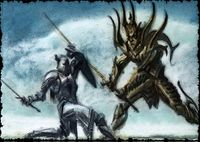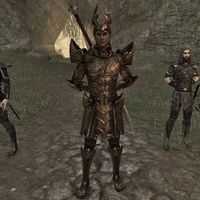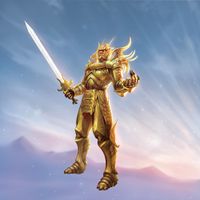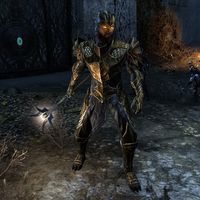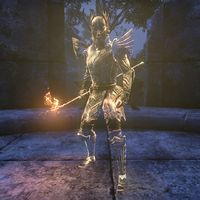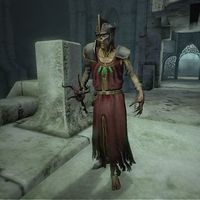Lore:Ayleid Empire
| Ayleid Empire | |||
|---|---|---|---|
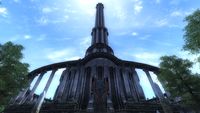 White-Gold Tower, Capital of the Ayleid Empire |
|||
| Middle Merethic Era – 1E 243 | |||
| Capital | White-Gold Tower | ||
| Location | Cyrodiil, Black Marsh | ||
| Demonym(s) | Ayleidic,[1] Ayleidish[2] | ||
| Common languages | Ayleidoon | ||
| Religions |
|
||
| Government | Allied city-states | ||
| Preceded By | Succeeded By | ||
|
|||
The Ayleid Empire (or imperatum saliache)[3] was the original dominant power in Cyrod.[4] It was composed of multiple city-states, ruled by the Ayleid sorcerer-kings.[5][6] The empire's roots began in the Middle Merethic Era, when established Ayleid settlements flourished in the Heartlands. Though they were ostensibly a tribute-land to the High King of Alinor, the distance between Cyrodiil and Summerset's communication lines led to the Ayleids' isolation and eventual detachment.[7] Their fall is attributed to their arrogant pride of their achievements and smug self-assurance that their empire would last forever, which doomed them to fail and fade into obscurity.[8]
Contents
History[edit]
Origins[edit]
The Elves who left the Summerset Isles to create splinter cultures in central and southwest Tamriel sometimes did so to evade the strictures of Aldmeri regulation, which forbade the worship of Daedra among other things. As Ayleid culture flourished in the last millennium of the Merethic Era, drawing ever further from Alinor, Daedric worship took hold and spread among the Heartland High Elves. The Aedra were still widely revered; unlike the Chimer, the Ayleids made no distinction between Good and Bad Daedra.[9] The White-Gold Tower, the capital of the Empire,[10] was founded circa 1E 0.[7] The height of their civilization was ME 900–850, before it succumbed to inner turmoil.[11]
Internal Conflicts[edit]
Sometime in the Merethic or early First Era, the city-states of Abagarlas and Delodiil, led by respective sorcerer-kings Anumaril and Cenedelin,[12] engaged in a series of conflicts over their religious patronage. While Abagarlas revered Molag Bal, Delodiil - in addition to the Divines - worshipped Meridia.[13] Meridia and Molag Bal were rivals,[14] resulting in dark manipulations from Anumaril on behalf of Bal.[15] In both religious pride and envious provocation from Cenedelin's dismissal of his shrine,[16] Anumaril went mad, destroying the statue of Meridia within Abagarlas and murdering a visiting family of Delodiils.[13] In order to ensure the destruction of Delodiil, Anumaril retreated to the heart of his temple, pleading for help from Molag Bal.[16] Bal answered the request with the Mortuum Vivicus, a magical relic capable of storing thousands of souls.[17]
Gathering his army of undead and bannermen, Anumaril marched for Delodiil, intent on harvesting their souls for the Mortuum Vivicus.[18][12] Meridia learned of the plan and warned Delodiil of the threat, prompting Cenedelin to issue a holy task to Curano, an Exarch and Brightblade.[12][19] After the willing sacrifices of several powerful priestesses, the Prismatic Weapon was forged, a blade capable of destroying the Mortuum Vivicus.[20] The newly formed Knights of the Gleaming Blade, afforded the entirety of Delodiil's armory,[19] infiltrated Abagarlas while Cenedelin rode against the city's dark walls with his full host. The Knights killed Anumaril's family, who were protecting the Mortuum Vivicus, and were successful in preventing the soul-collecting ritual.[12] Though Molag Bal saved the Mortuum Vivicus from destruction, Abagarlas was soon destroyed by the lightning of Meridia.[12][13]
The city's destruction could be seen and heard from Delodiil, where Anumaril and his forces had arrived. However, the entire city had mysteriously disappeared, leaving not a single brick present where it had once stood. Upon their hasty return to Abagarlas, Anumaril found only ruins. The war between the two city-states was the last that either of them appeared in history, as Abagarlas was never rebuilt and Delodiil was never seen again.[13]
The Empire suffered a civil war known as the Narfinsel Schism starting in the Late Merethic Era and lasting over 200 years into the First Era. The conflict saw battles between the Aedra- and Daedra-worshipping people of the Empire. The war reached its conclusion in 1E 198 with the Scouring of Wendelbek, with Sorcerer-King Glinferen of Atatar leading a combined force of Daedraphile warriors against the traditionalist, Aedra-worshipping Barsaebics of Wendelbek, driving them south into Black Marsh. The war marked the end of all organized opposition to Daedra worship within the empire.[21][22]
During the First Era,[23] Sorcerer-King Celemaril Light-Bringer, along with his undead forces, waged war across Tamriel,[24] striving for its destruction.[25] His brother Valentis, a prince,[23] gathered several other sorcerer-kings to stop Celemaril, leading a rebellion against him. With varla stones and an Elder Scroll, Valentis donned Celemaril's crown and spoke a ritual incantation, sealing his brother within a crypt beneath a marble statue bearing his likeness.[26][25][27] After successfully binding Celemaril, the victorious kings wiped his name from all records, treating it as cursed to speak.[24][28]
Alessian Slave Rebellion[edit]
Circa 1E 242,[29] Alessia, a Nedic slave of the Ayleids, launched a rebellion against the Ayleid Empire. Alongside her Demigod lover, Morihaus, and the legendary warrior Pelinal Whitestrake, she operated from Sancre Tor, fighting to topple the Empire and release the enslaved Nedic peoples across Cyrod.[30] Pelinal challenged various sorcerer-kings to duel: Hadhuul of Ceya-Tar, Haromir of Copper and Tea, and Gordhaur the Shaper of Ninendava all fell to him. He then rampaged through the city-states of Narlemae and Celediil before heading to Heldon. Though the Ayleids holding Heldon Bridge pushed back the advancing Nordic forces, Pelinal's interference turned the tide of the battle and won the bridge for the Alessians—an act which became known as "Pelinal's Midyear Massacre" in later Eras.[31] Afterward, the Crusader met with the rebel army to breach the Temple of the Ancestors.[5]
During the rebellion, King Glinferen of Atatar, who had commanded the Scouring of Wendelbek a half-century prior, called upon the Barsaebic Ayleids for assistance. The king of the Barsaebics, still stung from the humiliation of exile, sent him back a blunt refusal.[22] The Barsaebics distanced themselves from their Heartland kin, who served darker masters, hearkening back to the Narfinsel Schism.[32] Despite their shared animosity toward the Empire, the Barsaebics did not ally themselves with Alessia.[22]
Some city-states joined Alessia in rebellion against the Empire, most of them being holdover Aedra worshippers from the Narfinsel Schism.[9] However, some of the allied city-states worshiped Daedra, most notably Nenalata.[33][34] Laloriaran Dynar, the prince of Nenalata, fought alongside the Nedes, believing their cause to be true.[35] Some of these Ayleid supporters were given land and titles for their assistance.[34]
Fearing the gathering army outside of the Temple of the Ancestors, the Ayleids made a pact with the Aurorans of Meridia and appointed Umaril the Unfeathered, an immortal half-ada,[5] as their liege-lord.[36] Pelinal alone stormed through to reach Umaril, as the other rebel leaders thought it was too dangerous.[5] Eventually, he met Umaril at Vanua, challenging him to face him in combat. Umaril obliged, but only after sending underlings to weaken the Crusader. Still, Pelinal emerged victorious over the Sorcerer-King. Weakened from the fighting, Pelinal was killed by the remaining sorcerer-kings, who descended upon him and cut him into eight pieces in mockery of the Eight Divines.[5][3] Although Pelinal was slain, Umaril's defeat and the fall of the White-Gold Tower marked the end of the Ayleid Empire and the start of the Ayleid Diaspora.[21]
Leadership[edit]
Though the Ayleid Empire was referred to as 'the first Tamrielic empire' and Umaril the Unfeathered was referred to as the 'liege-lord' of other Ayleid kings,[37][36] Herminia Cinna, a published scholar of the Ayleids, insisted there was never one King of the Ayleids, and that instead, the Empire was divided into independent city-states, each ruled by a sorcerer-king. Each sorcerer-king's power waxed and waned over the course of the Empire,[38] and city-states often did not allow their neighbors within their walls.[4] The position of sorcerer-king was known to be passed hereditarily upon death,[33] but reign rarely passed to heirs without some kind of arcane intrigue.[39]
Before his appointment as champion, Umaril the Unfeathered was a king with a reputation for leadership in battle.[40][41] He commanded military conquests into neighboring regions, including Black Marsh[42] and the Sunnatren.[43] Additionally, he would disrupt the activities of the Khajiit nomads of Elsweyr that his enemies traded with.[44]
The Empire, though united at times, warred within itself on multiple occasions, with some notable conflicts being the Narfinsel Schism,[21] the war between Abagarlas and Delodiil,[13] and the rampage of Celemaril Light-Bringer.[27] The lasting effects of these conflicts, adding up to be comparable to a full civil war,[34] was said to have contributed to the fall of the White-Gold Tower and the Empire's collapse at the hands of the Alessians.[21]
Known Sorcerer-Kings[edit]
Gallery[edit]
Notes[edit]
- As the empire crumbled, the people of Garlas Malatar kept the Wrathstone hidden rather than use it to help defeat the rebels, as their foremost loyalty was to Meridia.[45][46]
- Assertions by Third Era scholars state that the city-states of the Ayleid Empire possessed armies of Daedra, provided to them by the Daedric Princes through Oblivion Gates.[47]
See Also[edit]
Books[edit]
- Ayleid Survivals in Valenwood by Cuinur of Cloudrest, 4th Tier Scholar of Tamrielic Minutiae — Thalmor report on the Ayleid Diaspora in the First Era
- Daedra Worship: The Ayleids by Phrastus of Elinhir — A description of Daedric worship by the Ayleids
- Meet the Character - King Narilmor by Tjurhane Fyrre — Biography of a zealous Meridia worshipper
- The Song of Pelinal — The life of Pelinal Whitestrake, assembled from various old fragmentary texts
- The Whithering of Delodiil by Unknown — An Ayleid legend surrounding the rivalry between two cities and their Daedric patrons
- White-Gold: The Ayleid Perspective — The start of foreward for a text about the Ayleids
References[edit]
- ^ Treatise on Ayleidic Cities
- ^ The Monomyth (French translation)
- ^ a b The Adabal-a — Morihaus
- ^ a b Meet the Character - King Narilmor — Tjurhane Fyrre
- ^ a b c d e The Song of Pelinal
- ^ Pocket Guide to the Empire, 1st Edition: Cyrodiil — Imperial Geographical Society, 2E 864
- ^ a b Before the Ages of Man — Aicantar of Shimerene
- ^ Glories and Laments — Alexandre Hetrard
- ^ a b Daedra Worship: The Ayleids — Phrastus of Elinhir
- ^ Umbacano's dialogue in Oblivion
- ^ Jeweled Ayleid Scabbard antiquity codex entries in ESO
- ^ a b c d e Curano's Journal — Curano
- ^ a b c d e The Whithering of Delodiil — Unknown
- ^ The Lightless Oubliette
- ^ Lanath's Journal — Lanath
- ^ a b The Unholy Temple
- ^ Guildmaster Sees-All-Colors' dialogue in ESO
- ^ By the Master's Mace
- ^ a b Knights of the Gleaming Blade — Lateesh
- ^ Valasha's Journal — Valasha
- ^ a b c d Ayleid Survivals in Valenwood — Cuinur of Cloudrest, 4th Tier Scholar of Tamrielic Minutiae
- ^ a b c Chancellor Abnur Tharn Answers Your Questions — Chancellor Abnur Tharn
- ^ a b Founder's Statue description in Blades
- ^ a b Telarendil's dialogue in Blades
- ^ a b Shulkunaak's dialogue in Blades
- ^ The mural in Valentis' tomb during A Tale of Two Brothers in Blades
- ^ a b Saashi's dialogue in Blades
- ^ The Ghost of Valentis' dialogue in Blades
- ^ Shezarr and the Divines — Faustillus Junius
- ^ The Legendary Sancre Tor — Matera Chapel
- ^ Predicant Maera's dialogue in ESO
- ^ Ayleid Statuette antiquity codex entries in ESO: Greymoor
- ^ a b A Life of Strife and Struggle — King Laloriaran Dynar
- ^ a b c The Last King of the Ayleids — Herminia Cinna
- ^ King Laloriaran Dynar's dialogue in ESO
- ^ a b Umaril is Undone — Thadoril
- ^ White-Gold: The Ayleid Perspective
- ^ Herminia Cinna's dialogue in Oblivion
- ^ Jeweled Skull of Ayleid Kings antiquity codex entries in ESO
- ^ Umaril's Radiance Wolf description in ESO
- ^ Unfeathered Crate description in ESO
- ^ Umaril's Radiance Guar description in ESO
- ^ Umaril's Radiance Elk description in ESO
- ^ Umaril's Radiance Senche description in ESO
- ^ The Weeping Woman's dialogue in ESO: Wrathstone
- ^ Tharayya's dialogue in ESO: Wrathstone
- ^ The Amulet of Kings — Wenengrus Monhona
|
|||||
